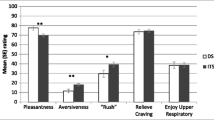Abstract
Rationale
Previous studies suggest that craving for cigarettes is substantially influenced by non-nicotine mechanisms such as habits, cues, and expectations. As orthodox Jews must refrain from smoking during the Sabbath, examining their craving levels during this habitual abstinence may be informative in separating smoking deprivation from other determinants of craving and withdrawal.
Objective
To examine the extent to which the habitual abstinence of Orthodox Jews during the Sabbath is associated with craving to smoke and with other reactions to smoking abstinence.
Methods
Twenty orthodox Jewish heavy smokers were assessed three times: on a workday when smoking as usual, on a Sabbath when they never smoke, and on a forced abstinence workday. Craving, irritability, and other commonly reported smoking withdrawal symptoms were assessed retrospectively at several time points during the preceding 24 h.
Results
Craving to smoke, and to a lesser extent, irritability, was lower during the Sabbath than during the two other test days. Self-reported difficulty in abstaining was also lower on the Sabbath than on the workday. Craving in the evening preceding the test day was always significantly higher than in the next morning, despite the overnight abstinence before the morning assessment.
Conclusions
These results support previous findings in showing that craving to smoke is determined to a large extent by smoking-related habits, cues, and expectations.


Similar content being viewed by others
References
American Psychiatric Association (1994) Diagnostic and statistical manual of the mental disorders (DSM-IV). American Psychiatric Association, Washington, DC
Blanchard EB, Wulfert E, Freidenberg BM, Malta LS (2000) Psychophysiological assessment of compulsive gamblers' arousal to gambling cues: a pilot study. Appl Psychophysiol Biofeedback 25:155–165
Dols M, Willems BW, van den Hout M, Bittoun R (2000) Smokers can learn to influence their urge to smoke. Addict Behav 25:103–108
Dols M, van den Hout M, Kindt M, Willems B (2002) The urge to smoke depends on the expectation of smoking. Addiction 97:87–93
Fedoroff IC, Polivy J, Herman CP (1997) The effect of pre-exposure to food cues on the eating bahavior of restrained and unrestrained eaters. Appetite 28:33–47
Garvey AJ, Bliss RE, Hitchcock JL, Heinold JW, Rosner B (1992) Predictors of smoking relapse among self-quitters: a report from the normative aging study. Addict Behav 17:367–377
Heatherton TF, Kozlowski LT, Frecker RC, Fagerström KO (1991) The Fagerström Test for Nicotine Dependence: a revision of the Fagerström tolerance questionnaire. Br J Addict 86:1119–1127
Jacober A, Hasenfratz M, Battig K (1994) Cigarette smoking: habit or nicotine maintenance? Effect of short-term smoking abstinence and oversmoking. Hum Psychopharmacol 9:117–123
Juliano LM, Brandon TH (1998) Reactivity to instructed smoking availability and environmental cues: evidence with urge and reaction time. Exp Clin Psychopharmacol 6:45–53
Kassel JD, Stroud LR, Paronis CA (2003) Smoking, stress, and negative affect: correlation, causation, and context across stages of smoking. Psychol Bull 129:270–304
Mackenzie TB, Ristvedt SL, Christenson GA, Lebow AS, Mitchell JE (1995) Identification of cues associated with compulsive, bulimic, and hair-pulling symptoms. J Behav Ther Exp Psychiatry 26:9–16
Marlatt GA (1985) Cognitive factors in the relapse process. In: Marlatt GA, Gordon JR (eds) Relapse prevention. Guilford, New York, pp 128–200
Modesto-Lowe V, Burleson JA, Hersh D, Bauer LO, Kranzler HR (1997) Effects of naltrexone on cue-elicited craving for alcohol and cocaine. Drug Alcohol Depend 49:9–16
Ristvedt SL, Mackenzie TB, Christenson GA (1993) Cues to obsessive–compulsive symptoms: relationships with other patient characteristics. Behav Res Ther 31:721–729
Russell MAH (1988) Nicotine replacement: the role of blood nicotine levels, their rate of change and nicotine tolerance. In: Pomerleau OF, Pomerleau CS (eds) Nicotine replacement: a critical evaluation. Liss, New York, pp 63–94
Sayette M, Hufford M (1994) Effects of cue exposure and deprivation on cognitive resources in smokers. J Abnorm Psychol 103:812–818
Sayette MA, Martin CS, Wertz JM, Shiffman S, Perrott MA (2001) A multidimensional analysis of cue-elicited craving in heavy smokers and tobacco chippers. Addiction 96:1419–1432
Sayette MA, Wertz JM, Martin CS, Cohn JF, Perrott MA, Hobel J (2003) Effects of smoking opportunity on cue-elicited urge: a facial coding analysis. Exp Clin Psychopharmacol 11:218–227
Schachter S, Silverstein B, Perlick D (1977) Psychological and pharmacological explanations of smoking under stress. J Exp Psychol Gen 106:31–40
Sherman JE, Zinser MC, Sideroff SI, Baker TB (1989) Subjective dimensions of heroin urges: influence of heroin-related and affectively negative stimuli. Addict Behav 14:611–623
Stolerman IP, Jarvis MJ (1995) The scientific case that nicotine is addictive. Psychopharmacology 117:2–10
Thewissen R, van den Hout M, Havermans RC, Jansen A (2005) Context dependency of cue-elicited urge to smoke. Addiction 100:387–396
Tiffany ST (1990) A cognitive model of drug urges and drug-use behavior: role of automatic and nonautomatic processes. Psychol Rev 97:147–168
Warburton DM (1990) Heroin, cocaine and now nicotine. In: Warburton DM (ed) Addiction controversies. Harwood Academic Publisher, Switzerland, pp 21–35
Wertz JM, Sayette MA (2001) A review of the effects of perceived drug use opportunity on self-reported urge. Exp Clin Psychopharmacol 9:3–13
West RJ, Schneider N (1987) Craving for cigarettes. Br J Addict 82:407–415
Willner P, Hardman S, Eaton G (1995) Subjective and behavioral evaluation of cigarette craving. Psychopharmacology (Berlin) 118:171–177
Author information
Authors and Affiliations
Corresponding author
Rights and permissions
About this article
Cite this article
Dar, R., Stronguin, F., Marouani, R. et al. Craving to smoke in orthodox Jewish smokers who abstain on the Sabbath: a comparison to a baseline and a forced abstinence workday. Psychopharmacology 183, 294–299 (2005). https://doi.org/10.1007/s00213-005-0192-3
Received:
Accepted:
Published:
Issue Date:
DOI: https://doi.org/10.1007/s00213-005-0192-3




